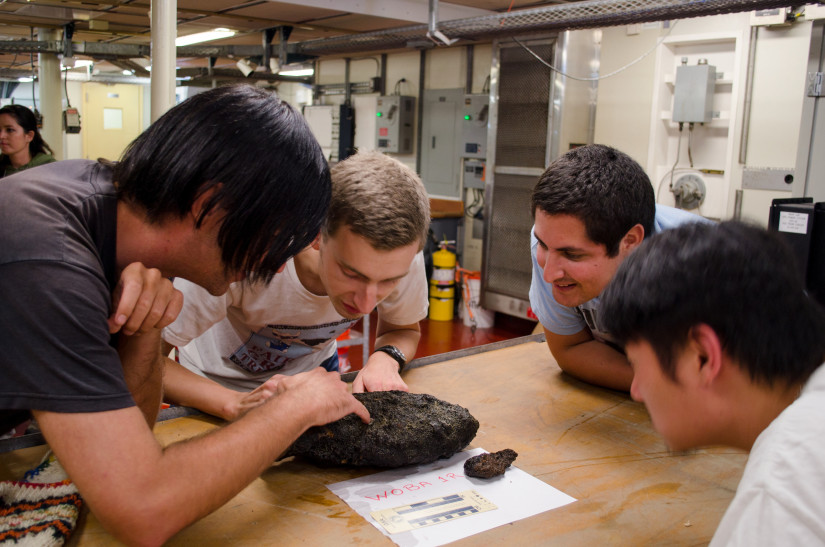Three main processes are known to generate the thick, stable, ancient rock that forms the roots of a continent, according to geologists.
Diving of one tectonic plate beneath the other (which geologists call “subduction”) accounts for two of the three known processes that can create the buoyant rock destined to become attached to continental landmasses. The other process is linked to streams of hot upwelling rock called mantle plumes that rise from deep within the Earth.
Now, scientists at UC San Diego’s Scripps Institution of Oceanography have found evidence that a fourth process called “ridge-jump tectonics” can also grow these continental roots.
The researchers based their analysis on rocks dredged from a geologically active area of the Pacific Ocean floor about 95 miles (153 km) west of Mexico’s Baja Peninsula by the now-retired Scripps research vessel Melville in 2012 by scientists from Scripps and two Mexican universities, the National Autonomous University of Mexico (UNAM) and Centro de Investigación Científica y de Educación Superior de Ensenada (CICESE). Analytical details of the structure and trace elements of the rocks appear in the American Geophysical Union journal Geochemistry, Geophysics, Geosystems.
“A lot of things have changed out there over the last 15 to 20 million years, which in geological terms is not much time,” said the paper’s lead author, Brian Oller, a Scripps Oceanography PhD student. “The result shows a very complicated geologic environment that has been difficult to unwind. Luckily for me, a lot of really smart, talented people have gone out there to unwind some of that story.”
Among them was Peter Lonsdale, a Scripps Oceanography emeritus professor of geology and co-author of the “ridge-jump tectonics” paper. His research helped tell the story of the geologically active area. About 20 million years ago, the area was a subduction zone, where slabs of seafloor slowly plunged into the Earth’s interior.

The new “ridge-jump” process can happen in a system of mid-ocean ridges, along which new lava erupts to form seafloor. An expanding rift along one of these ridges can cause it to overtake another nearby, dying ridge. As the area geologically reorganizes, sections of low-density rock can become attached to the edge of a continent, forming new landmass.
“This idea of ‘ridge-jump’ to produce new continental material that will lead to stable landmasses is new,” said James Day, a co-author of the paper and director of the Scripps Isotope Geochemistry Laboratory (SIGL). Ridge jump was a known process that now assumes a larger role in modern geologic processes due to its link to continent formation.
“In my view, it’s probably the most likely mechanism in the modern evolution of Earth for continent formation, where in the distant past ridge-jump as a process was probably less likely,” Day said.
Oller identified the ridge-jump process in the Pacific Ocean near the Baja Peninsula, but it occurs in association with rift zones around the world, including potentially in the East African Rift where the Earth’s tectonic plates have split apart.
“This is something that will be interesting to look at in the future,” said Day, who also serves as Oller’s PhD co-advisor. The leading ideas pointed to subduction and mantle plumes as the major players in continent formation.
“Brian offers a new mechanism that is quite logical,” said Day.
Geologists well understand how the roots of ancient continents could have formed, likely from large mantle plumes that developed billions of years ago when Earth’s interior would have been much hotter than today. But that process probably no longer applies to continent formation.
For example, formation of younger continental roots underlying the western U.S. and much of the rest of the world’s continental crust require other mechanisms which are not well understood.
“Ridge jump offers an explanation for how that process occurs,” Oller said.
Oller needed a suite of advanced laboratory instruments to complete his study. Meticulous study and use of mass spectrometers in the SIGL to measure the samples provided an important way to track the complicated geologic history of the pieces of Earth’s mantle dredged from the Ferrel Seamount, a submarine volcano.
The study co-authors include Neal Driscoll, a Scripps Oceanography professor in geophysical sciences and PhD co-adviser to Oller. Funding for this research was provided by National Science Foundation grants EAR 1147130 and EAR 1918211.
About Scripps Oceanography
Scripps Institution of Oceanography at the University of California San Diego is one of the world’s most important centers for global earth science research and education. In its second century of discovery, Scripps scientists work to understand and protect the planet, and investigate our oceans, Earth, and atmosphere to find solutions to our greatest environmental challenges. Scripps offers unparalleled education and training for the next generation of scientific and environmental leaders through its undergraduate, master’s and doctoral programs. The institution also operates a fleet of four oceanographic research vessels, and is home to Birch Aquarium at Scripps, the public exploration center that welcomes 500,000 visitors each year.
About UC San Diego
At the University of California San Diego, we embrace a culture of exploration and experimentation. Established in 1960, UC San Diego has been shaped by exceptional scholars who aren’t afraid to look deeper, challenge expectations and redefine conventional wisdom. As one of the top 15 research universities in the world, we are driving innovation and change to advance society, propel economic growth and make our world a better place. Learn more at ucsd.edu.



